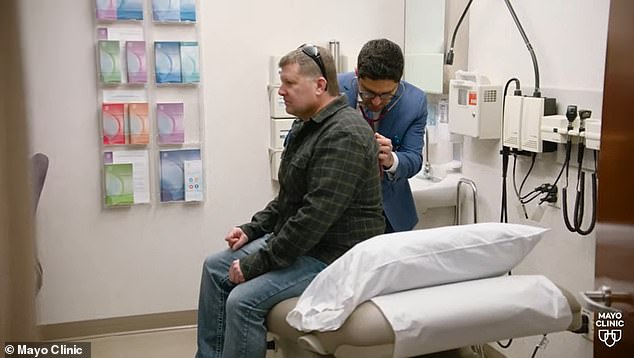I thought I had heartburn, but then doctors discovered a ticking ‘time bomb’ condition that could kill me at any moment






For years, Rich Bugay suffered from a burning mouth, which he thought was caused by heartburn.
But no matter how often the Michigan father of three used cough drops, the symptoms never seemed to go away.
For years, doctors couldn’t diagnose him. Some thought he had chronic reflux and he even had a colonoscopy, which “ruled out a lot of things.”
But then his symptoms worsened and he developed extreme fatigue. Some days he could barely walk.
It wasn’t until he was referred to the Mayo Clinic that doctors discovered he had a heart condition that could kill him at any moment.

Rich Bugay, of Escanaba, Michigan, drove nearly seven hours to see doctors for a sore mouth he had been experiencing for years

After being diagnosed with an aortic aneurysm, he was rushed into open heart surgery. He is pictured above before the procedure
He was diagnosed with an aortic aneurysm, a swollen bulge in the main artery leading from the heart that measures 7 cm in diameter.
This increases the risk of a tear, because the arterial wall becomes thinner as it swells and therefore becomes more stressed.
Aortic aneurysms are fatal in 80 to 90 percent of cases if they rupture, because of the severe internal bleeding they cause.
Announcing his diagnosis, Mr Bugay said: “[The doctor] encouraged me that it was solvable, but said, ‘You don’t have many options when it comes to waiting because you’re essentially a ticking time bomb.’
Doctors at the Mayo Clinic in Rochester, Minnesota, rushed him to the clinic for open-heart surgery just four days after his diagnosis.
He spent a few days in hospital recovering and has since been discharged home, with doctors saying he is recovering well.
Doctors told him the aneurysm was causing a burning sensation in his mouth because it could be blocking nearby nerves leading to that area, causing pain and discomfort.
It is not clear what caused Mr Bugay’s swollen artery, but in previous cases it has been linked to smoking, high blood pressure and infection.
A family history of the disease and genetic factors are also thought to increase the risk.

Doctors determined that his suspected acid reflux was not a stomach problem after detecting a heart murmur, or an unusual sound when listening to the heart.

Mr. Bugay is pictured above before his surgery

And this scan shows the swollen area that indicated he had an aortic aneurysm
Scans also showed that Mr Bugay was born with a congenital heart defect called bicuspid aortic valve syndrome.
This is when a person has only two tissue valves that keep blood flowing properly, instead of the usual three.
Doctors told Mr Bugay they believed this was also causing some of his blood to flow back with each heartbeat, making him extremely tired.
Mr Bugay said: ‘I was feeling unwell, I was having heartburn, stomach upset and I went to different doctors, including my GP, but I didn’t get any answers.
“At some point I decided I wanted to go to the best place I could get to.”
After being diagnosed with heart disease, he said, “I was a bit sick to my stomach because I wanted relief from what I had and I didn’t think it was life-threatening.
During open-heart surgery, doctors first make a large incision in the chest and cut open the breastbone to access the heart.
They then clamped the aorta above and below the aneurysm and cut away the damaged portion, replacing it with a graft, a tube made of durable material.
The clamps stop the blood flow during the surgery, where doctors rely on a heart-lung machine to keep blood flowing to the rest of the body. The heart does not stop.
Surgeons also treated his bicuspid aortic valve syndrome by removing his old heart valves and implanting a mechanical version that opens and closes more completely.
Mr Bugay is pleased with the surgery and says he feels like he is almost 100 percent again.
About 200,000 Americans have an aortic aneurysm, most of whom are men and over age 65.
But in many cases the condition remains undetected because no symptoms occur.
If symptoms do occur, you may experience shortness of breath, dizziness and difficulty swallowing.




